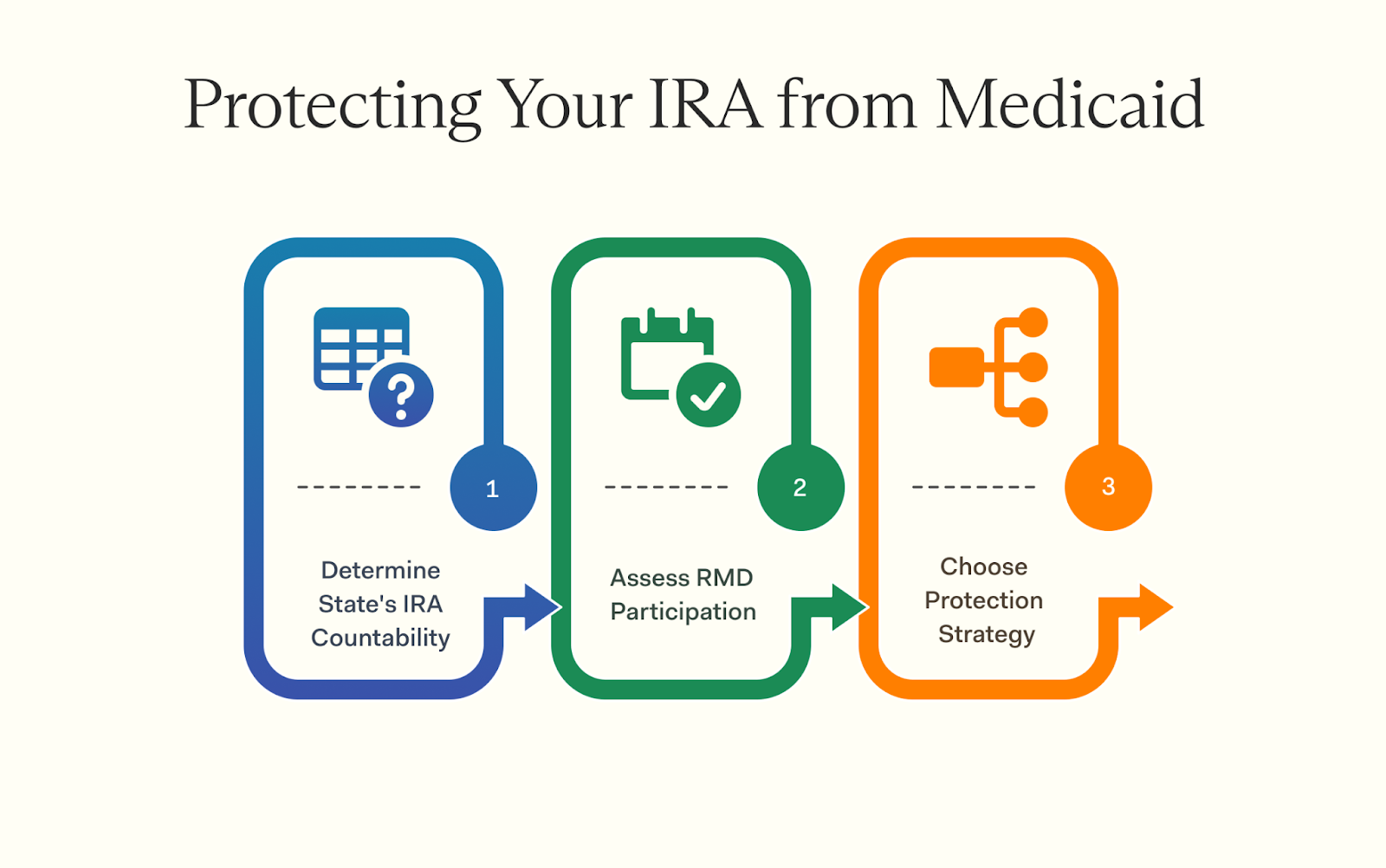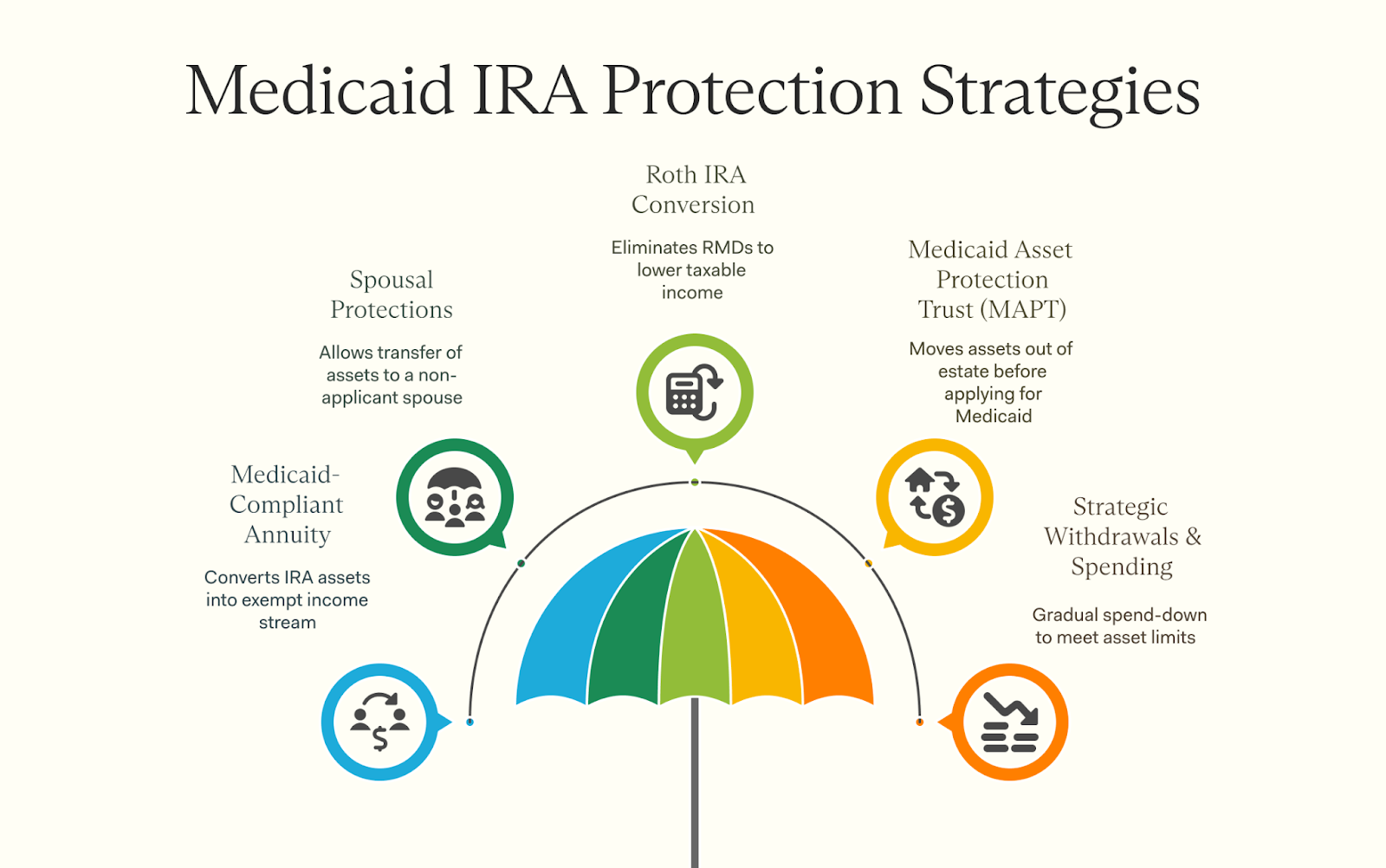Understand IRA Medicaid rules for eligibility and how they impact your planning. Get the insights you need to navigate this complex landscape.
Concerned about your IRA affecting Medicaid eligibility? With strict asset and income limits, your retirement savings could indeed impact your qualification for these essential benefits.
This guide explores effective strategies to protect your IRA while maintaining Medicaid eligibility, including specialized trust structures and strategic Roth IRA conversions. Discover how proper planning can help secure both your healthcare coverage and your hard-earned retirement assets.
Medicaid eligibility hinges significantly on asset limits, which vary broadly by state. While many states set the individual asset limit at $2,000, married couples may qualify for substantially higher thresholds—such as $17,500 in Illinois and $42,312 in New York. For accurate information, it's essential to consult state-specific guidelines.
Countable assets include cash, stocks, and retirement accounts, including IRAs. The treatment of IRAs differs across states—some count them as assets, while others exempt them if they're in payout status, creating significant variation in how retirement savings affect eligibility.
Rules governing asset limits and IRA treatment can vary dramatically between states. In some regions, the balance in an IRA can directly influence whether you qualify for Medicaid benefits.
If you're worried about how your IRA might affect your Medicaid eligibility, or how retirement accounts could impact financial qualification for programs like Nursing Home Medicaid or HCBS waivers, consider consulting an elder law attorney.
These specialists excel at interpreting complex regulations regarding the impact of retirement savings on Medicaid qualification.
It's also important to note that required minimum distributions (RMDs) from IRAs must begin at age 73, following changes under the SECURE 2.0 Act of 2022. These withdrawals count as income that could potentially affect Medicaid eligibility based on both income and asset evaluations.
Your retirement accounts count as assets and may affect Medicaid eligibility by exceeding asset limits, potentially disqualifying you from assistance.
The payout status of your IRA plays a crucial role in Medicaid eligibility. IRAs come with specific distribution rules that, if not followed, can jeopardize your Medicaid application.
Monthly payments from an IRA count as income, which could push you over Medicaid's income threshold.
Distributions must begin by age 73, calculated using IRS life expectancy tables. Traditional IRAs and 401(k)s require these distributions to avoid tax penalties, which have been reduced under the SECURE 2.0 Act to 25% of the RMD amount not taken, and further reduced to 10% if corrected promptly.
Understanding these regulations helps protect your savings from being depleted to cover care costs.

Several strategies can safeguard your IRA from Medicaid asset calculations. Options include establishing specialized trusts or converting your retirement account type. Each approach comes with distinct rules and advantages.
Medicaid Asset Protection Trusts can shield assets from Medicaid eligibility calculations, but there's a catch with IRAs. These retirement accounts cannot be transferred directly into a MAPT without first being liquidated, which triggers immediate income taxes on the entire balance, potentially creating a substantial tax burden.
While MAPTs provide asset protection, liquidating an IRA to fund one may not always be advisable. Consulting a financial advisor can help assess tax consequences and explore alternatives.
MAPTs should be funded at least five years before applying for Medicaid to avoid penalties, as transfers within the five-year look-back period can result in Medicaid ineligibility. Proper planning ensures compliance while preserving wealth. Married couples may also benefit from additional spousal protections when navigating Medicaid rules.
Converting from a traditional IRA to a Roth IRA requires paying taxes on the converted amount upfront. However, this conversion doesn't shield your assets from Medicaid, as the account balance remains part of asset calculations.
Roth IRAs offer one advantage: unlike traditional IRAs, they don't require minimum distributions (RMDs) during your lifetime, potentially keeping your taxable income lower.
Nevertheless, most states count Roth IRA balances as assets for Medicaid eligibility, as they typically don't exempt these accounts from asset calculations.
Careful planning is essential to avoid unintended consequences. Working with a financial advisor or elder law attorney can help you navigate the complex rules governing retirement accounts and Medicaid eligibility.
Medicaid-compliant annuities offer a way to protect assets from Medicaid's scrutiny by converting non-exempt assets into income streams. These specialized annuities provide regular payments, helping you meet Medicaid's financial eligibility requirements without depleting all your assets. However, the resulting income may affect Medicaid's income eligibility criteria.
This strategy effectively transforms countable assets into exempt income, reducing your countable assets while providing monthly income. The key consideration is that while the asset itself no longer counts, the income it generates might affect Medicaid's income thresholds.
This approach particularly benefits Medicaid applicants seeking in-home care assistance or other services. For compliance, the annuity must meet specific Medicaid requirements: it must be irrevocable, non-transferable, actuarially sound, and provide equal payments.

When planning for Medicaid, spousal protections offer significant safeguards for retirement assets. If one spouse requires Medicaid, the non-applicant spouse can retain certain assets. Retirement accounts, including IRAs and 401(k)s, often benefit from these protections.
Many states allow the non-applicant spouse to keep a portion of the couple's combined assets under the Community Spouse Resource Allowance (CSRA).
All states establish specific CSRA limits that determine how much the community spouse can retain, though the amounts and regulations vary considerably across jurisdictions. Understanding your state's particular rules is essential for effective planning. These protections can help secure your financial future while ensuring your partner receives necessary care. Advance planning provides the greatest advantage in navigating these complex rules.
Retirement accounts become particularly vulnerable when long-term care needs arise. Most people only discover Medicaid's stringent asset limitations during a health crisis—when options have narrowed and stress levels peak.
A Farther financial advisor can guide you through these complexities before challenges emerge. Our services include establishing Medicaid Asset Protection Trusts early to satisfy the five-year look-back period and evaluating whether Roth conversions align with your broader financial strategy, considering both tax implications and Medicaid eligibility.
Don't postpone planning until you're forced to choose between financial stability and healthcare needs. Connect with a Farther advisor today and secure your peace of mind.
Protecting your IRA from Medicaid requires understanding the complex interplay between retirement savings and healthcare benefits. You've explored key considerations including asset limits, eligibility rules, and strategic planning options. While methods like Medicaid Asset Protection Trusts can be effective, options such as Roth IRA conversions come with important considerations.
Have you evaluated how these strategies align with your retirement goals? Professional guidance can provide tailored advice and help you navigate potential pitfalls. Taking proactive steps today can prevent difficult decisions later and preserve your hard-earned retirement funds.
Stay informed, weigh your options carefully, and take appropriate action—your financial security depends on it!
An Individual Retirement Account (IRA) can affect your Medicaid eligibility. Depending on your marital status and where you live, it may be considered a non-exempt asset that counts towards income and resource limits for Medicaid programs. Treatment of IRAs varies by state, with variations depending on whether they are in payout status.
If you're married, the applicant's spouse's retirement plan, like a 401(k), could potentially be treated as a non-countable asset depending on state regulations. The treatment of a non-applicant spouse's retirement account differs by state, and these accounts can sometimes be exempt regardless of payout status or only if in payout status.
Yes, some states—like Florida, Georgia, Ohio, Kentucky, and New York—exempt IRAs under certain conditions in their eligibility determinations for programs like HCBS Medicaid Waiver which provides in-home care assistance. For instance, Florida exempts IRAs if they are in payout status, whereas Kentucky exempts them regardless of payout status.
Withdrawing from your individual retirement account before age 59½ usually triggers an income tax penalty unless exceptions apply. While exceptions like birth or adoption expenses under the Secure Act do exist, planning withdrawals for Medicaid qualification specifically may incur penalties and have significant tax consequences.
Yes! The Required Minimum Distribution (RMD) rules mandate how much you must withdraw annually starting from age 73 as of January 1, 2023, a change implemented by the SECURE Act 2.0 aimed at enhancing retirement savings.
Absolutely! Bank accounts, real estate properties beyond one's primary residence, and other financial instruments like stocks, bonds, and certificates of deposit, which are easily converted to cash, are among those commonly classified as non-exempt assets which could influence your Medicaid eligible status.